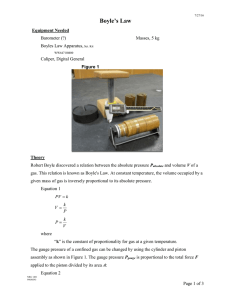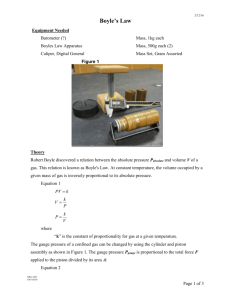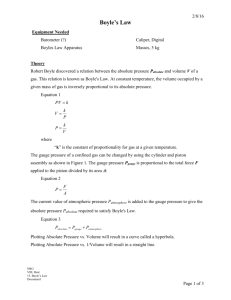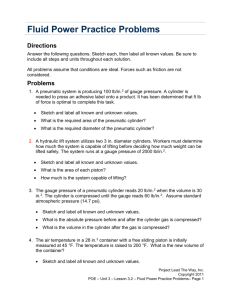Boyles Law - University of Manchester
advertisement
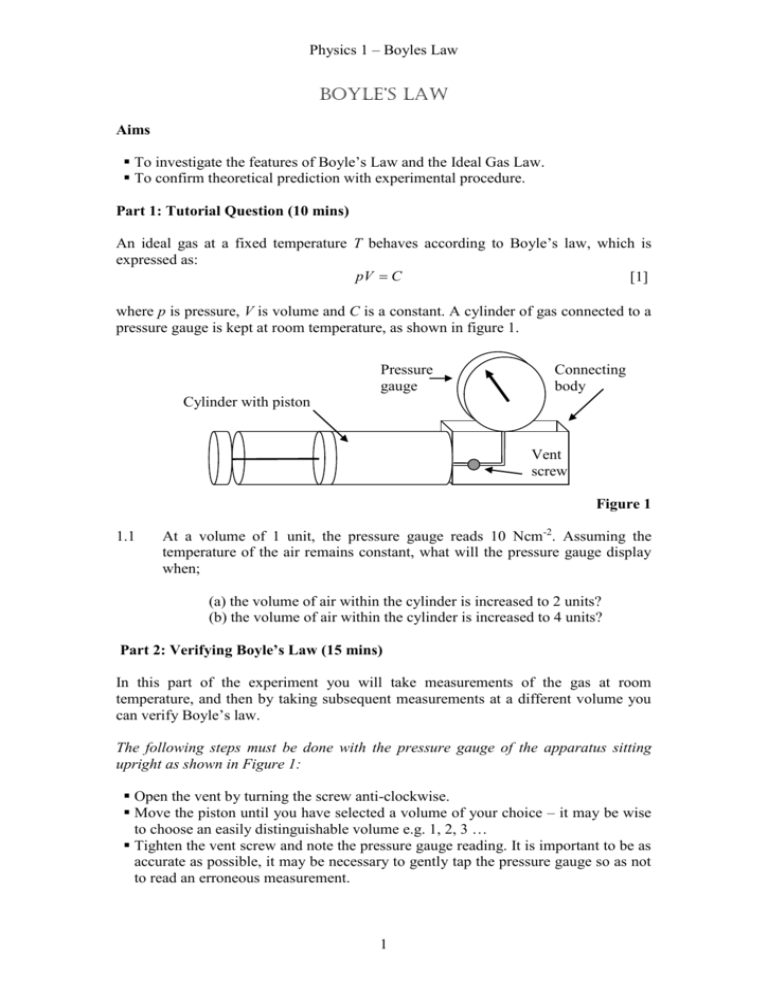
Physics 1 – Boyles Law Boyle’s law Aims To investigate the features of Boyle’s Law and the Ideal Gas Law. To confirm theoretical prediction with experimental procedure. Part 1: Tutorial Question (10 mins) An ideal gas at a fixed temperature T behaves according to Boyle’s law, which is expressed as: pV C [1] where p is pressure, V is volume and C is a constant. A cylinder of gas connected to a pressure gauge is kept at room temperature, as shown in figure 1. Pressure gauge Connecting body Cylinder with piston Vent screw Figure 1 1.1 At a volume of 1 unit, the pressure gauge reads 10 Ncm-2. Assuming the temperature of the air remains constant, what will the pressure gauge display when; (a) the volume of air within the cylinder is increased to 2 units? (b) the volume of air within the cylinder is increased to 4 units? Part 2: Verifying Boyle’s Law (15 mins) In this part of the experiment you will take measurements of the gas at room temperature, and then by taking subsequent measurements at a different volume you can verify Boyle’s law. The following steps must be done with the pressure gauge of the apparatus sitting upright as shown in Figure 1: Open the vent by turning the screw anti-clockwise. Move the piston until you have selected a volume of your choice – it may be wise to choose an easily distinguishable volume e.g. 1, 2, 3 … Tighten the vent screw and note the pressure gauge reading. It is important to be as accurate as possible, it may be necessary to gently tap the pressure gauge so as not to read an erroneous measurement. 1 Physics 1 – Boyles Law Change the volume of the air by pulling/pushing the piston at the end of the cylinder. Note both your new volume and the new pressure gauge reading. 2.1 Assuming the temperature of the air inside the cylinder is at the same temperature as initially, verify Equation 1. Part 3: Tutorial Question (10 mins) The ideal gas law is given as: pV nRT [2] 3.1 State what each of the symbols represents. 3.2 What is the dimension (units) of the left hand side of equation 2? Given that a Newton metre, Nm, is dimensionally equivalent to a joule, J, write down the dimensions of R. 3.3 The volume of 1 unit on the cylinder is 47.12 10 6 m3, which at a temperature of 300 K, contains 1.9 10 11 moles of air. If the volume is kept constant but the pressure gauge is observed to change from 10 Ncm-2 to 11 Ncm-2, calculate the new temperature of the air. Hints: (a)1 m2 = 10,000 cm2, 1 Nm = 1 Pa, R = 8.315 Jmol-1K-1 (b) is there an easy method to do this?! Part 4: Verifying the Ideal Gas Law (15 mins) In this part of the experimental tutorial you will change the temperature of the air inside the cylinder and keep the volume constant. A change in pressure will occur and you will then be able to verify the ideal gas law. The following steps must be done with the apparatus sitting up right as shown in Figure 1: Select a reference volume which gives a pressure gauge reading of 10 Ncm -2 and ensure the vent screw is tightly closed. Note this volume in your lab book along with the room temperature. Now raise the temperature of the cylinder by placing it in the basin and covering with a hot water bottle. Please take care when filling these bottles by using the funnels provided to reduce the risk of scalding. It will take around 5mins for the temperature of the gas inside the cylinder to raise enough to make a noticeable difference on the pressure gauge, e.g. 11 Ncm-2. Ensure the volume doesn’t change. It may be necessary to readjust the piston back to the reference volume. Assuming the gas is now at the same temperature of the cylinder, use the infra-red thermometer to measure this temperature. This is best done by taking several readings at different angles and averaging the temperatures showing similarity. 2 Physics 1 – Boyles Law 4.1 Using the ideal gas law, deduce the relationship between the initial pressure/volume/temperature and the final pressure/volume/temperature. 4.2 Hence, or otherwise, calculate the final temperature of the air within the cylinder and compare it with the temperature you measured. Discuss any causes for deviation. Further work The following questions are related to the topic covered by this experimental tutorial. From the examples book H16-H33 Mastering Physics question details will be sent by Miles Padgett, m.padgett@physics.gla.ac.uk 3 Physics 1 – Boyles Law Demonstrators' Answers, Hints, Marking Scheme and Equipment List. Marking Scheme Section 1.1a 1.1b 2.1 3.1 3.2 3.3a 3.3b 4.1 4.2 Discretionary mark TOTAL Mark 1 1 1 1 1 1 1 1 1 1 10 Answers 1.1a/b As it can be seen below, any choice of volume units the student makes will give the same result: 2.1 Volume (units) Volume (m3) Pressure (N/cm2) Pressure (N/m2) Initial 1 4.71239E-05 10 0.001 Final 2 9.42478E-05 5 0.0005 Final 4 0.000188496 2.5 0.00025 Constant (Nm) 4.71239E08 4.71239E08 4.71239E08 Expect results comparable to theory but not exact, e.g. below you can see the difference in the constant: Volume (units) Volume (m3) Pressure (N/cm2) Pressure (N/m2) Constant (Nm) Initial 1 4.71239E-05 10 0.001 4.71E-08 Final 3 0.000141372 3.75 0.000375 5.3E-08 3.1 n is the number of moles, R is the ideal gas constant, T is the temperature. 3.2 Nm, 3.3 330K 4.1 PiVi Pf V f Ti Tf Jmol-1K-1 4 Physics 1 – Boyles Law 4.2 for a pressure change from 10 Ncm-2 to 11 Ncm-2 students should obtain 330K = 57 oC. Equipment List: Hot water bottle Infrared thermometer Piston/pressure gauge system Tray 5 Physics 1 – Boyles Law 6
